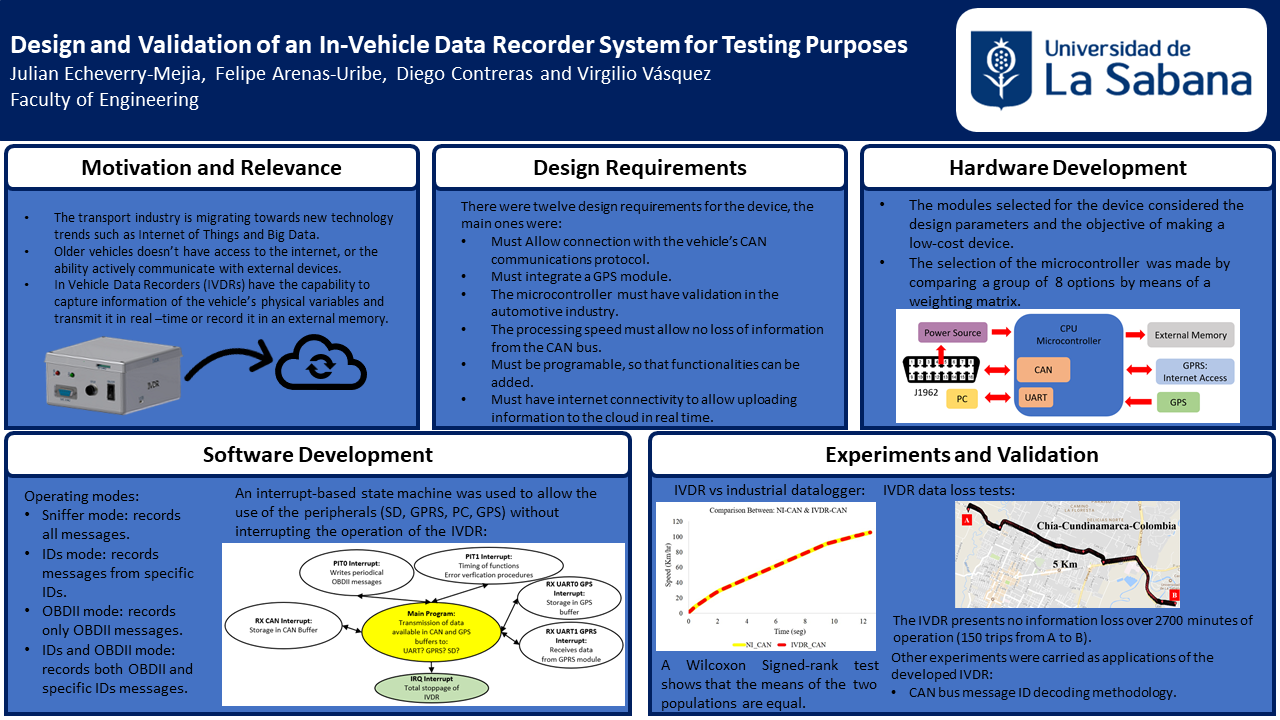Design and Validation of an In-Vehicle Data Recorder System for Testing Purposes
Keywords:
— Automotive communication protocols, CAN bus, In-Vehicle Data Recorder, OBDII, Typical Driving CyclesAbstract
This paper presents the design and statistical validation of an In-Vehicle Data Recorder System (IVDR) for testing purposes, implementing the use of CAN bus (Controller Area Network) communications protocol through the SAE J1962 port. The device works according to an interrupt-based algorithm that reads the vehicle’s sensor data sent through the CAN bus network. This data is stored in an external memory card and sent to a server using a General Packet Radio Services (GPRS) module, it can also be connected to a computer to view the data in real time. The proposed IVDR was thoroughly validated by means of multiple experiments, including one in which its performance was compared to an industrial use device with similar functions, it has also already been used in the development of a Typical Driving Cycle (TDC) for the city of Chía in Colombia. Statistical analysis shows that the device performs similarly against commercial devices and complies with SAE standard guidelines, presenting the device as a low-cost and reliable option for testing purposes and massively distributed IoT applications.
Downloads
References
H. Weber, J. Krings, J. Seyfferth, H. Güthner and J. Neuhausen, "Digital
Auto Report 2019", 2019.
A. Chidester, J. Hinch and T. Roston, "Real World Experience With
Event Data Recorders", National Highway Traffic Safety
Administration. Paper Number 247, 2001.
J. Echeverry, “Metodología Para Reducir El Gasto De Combustible En
Rutas Fijas Mediante El Uso De Hábitos De Conducción Eficiente,
Empleando Un Sistema IVDR Y Ciclos De Conducción”, ITESM
Campus Estado de México, 2018.
J. Huertas, J. Díaz, D. Cordero y K. Cedillo, «A new methodology to
determine typical driving cycles for the design of vehicles power trains,»
Int J Interact Des Manuf, 2017.
S. Kamble, T. Mathew y G. Sharma, «Development of real-world
driving cycle: Case study of Pune, India,» Transportation Research Part
D, pp. 132-140, 2009.
D. Cordero y J. Huertas, «Metodología para minimizar el consumo de
combustible en autobuses, que sirven rutas fijas, mediante la
reconfiguración del tren motriz,» ITESM Campus Toluca, Toluca,
México, 2015.
Society of Automotive Engineers (SAE). On-Board Diagnostic
Connector, J1962. 2016.
Echeverry, J., Vasquez, V., Aguirre, J., and Contreras, D., "Low Cost
Obtainment of Vehicle Performance Curves and Values Experimentally
by Means of the OBD2 Port," SAE Technical Paper 2015-01-0588,
, doi:10.4271/2015-01-0588.
S. Birrell y M. Fowkes, «Glance behaviours when using an in- vehicle
smart driving aid: A real-world, on-road driving study,» Transportation
Research Part F, 2014.
B. Sung-hyun y J. Jong-Wook, «Implementation of integrated OBD-II
connector with external network,» INFORMATION SYSTEMS, 2015.
K. Smith and J. Miller, "OBDII Data Logger Design for Large-Scale
Deployments", Proceedings of the 16th International IEEE Annual
Conference on Intelligent Transportation Systems, 2013.
S. Garcia et al., "System for the realization of advanced mobility studies
based on driver, cabin and vehicle monitoring", IEEE Latin America
Transactions, vol. 100, no. 1, 2020.
ISO 15765-4:2016. ISO. Road vehicles — Diagnostic communication
over Controller Area Network (DoCAN) — Part 4: Requirements for
emissions-related systems, 2005.
M. Di Natale, H. Zeng, P. Giusto y A. Ghosal, Understanding and Using
the Controller Area Network Communication Protocol: Theory and
Practice, Springer, 2012.
ISO 15031–5:2015. ISO. Road vehicles — Communication between
vehicle and external equipment for emissions-related diagnostics — Part
: Emissions-related diagnostic services.
Society of Automotive Engineers (SAE). OBD II Scan Tool --
Equivalent to ISO/DIS 15031–4, J1978. 2011.
SIMCom, SIM800 Series AT Command Manual, 2015.
SiRF Technology Inc., NMEA Reference Manual, 2nd ed. San Jose,
California, USA., 2007.
Society of Automotive Engineers (SAE). Vehicle Acceleration
Measurment, J1491. 2006.
V. Vasquez Lopez, J. Echeverry Mejia and D. Contreras Dominguez,
"Design and Statistical Validation of Spark Ignition Engine Electronic
Control Unit for Hardware-in-the-Loop Testing", IEEE Latin America
Transactions, vol. 15, no. 8, pp. 1376-1383, 2017. Available:
1109/tla.2017.7994782.
L. Moreira-Matias and H. Farah, "On Developing a Driver Identification
Methodology Using In-Vehicle Data Recorders," in IEEE Transactions
on Intelligent Transportation Systems, vol. 18, no. 9, pp. 2387-2396,
Sept. 2017, doi: 10.1109/TITS.2016.2639361.
Galit Toledo, Yoram Shiftan, “Can feedback from in-vehicle data
recorders improve driver behavior and reduce fuel consumption?”
Transportation Research Part A: Policy and Practice, Vol. 94, 2016, pp.
-204
Victoria Gitelman, Shlomo Bekhor, Etti Doveh, Fany Pesahov, Roby
Carmel, Smadar Morik. Exploring relationships between driving events
identified by in-vehicle data recorders, infrastructure characteristics and
road crashes. Transportation Research Part C: Emerging Technologies,
Vol 91, pp. 156-175, 2018
Gila Albert, Tsippy Lotan, Tomer Toledo, Einat Grimberg, Mariano
Lasebnik. Are young drivers as careful as they deem? In vehicle data
recorders and self reports evaluations. Eur. Transp. Res. Rev., vol. 6 pp.
–476, 2014.
Borgeest Kai. 1.3.1 CAN Bus. In EMC and Functional Safety of
Automotive Electronics. Institution of Engineering and Technology.


